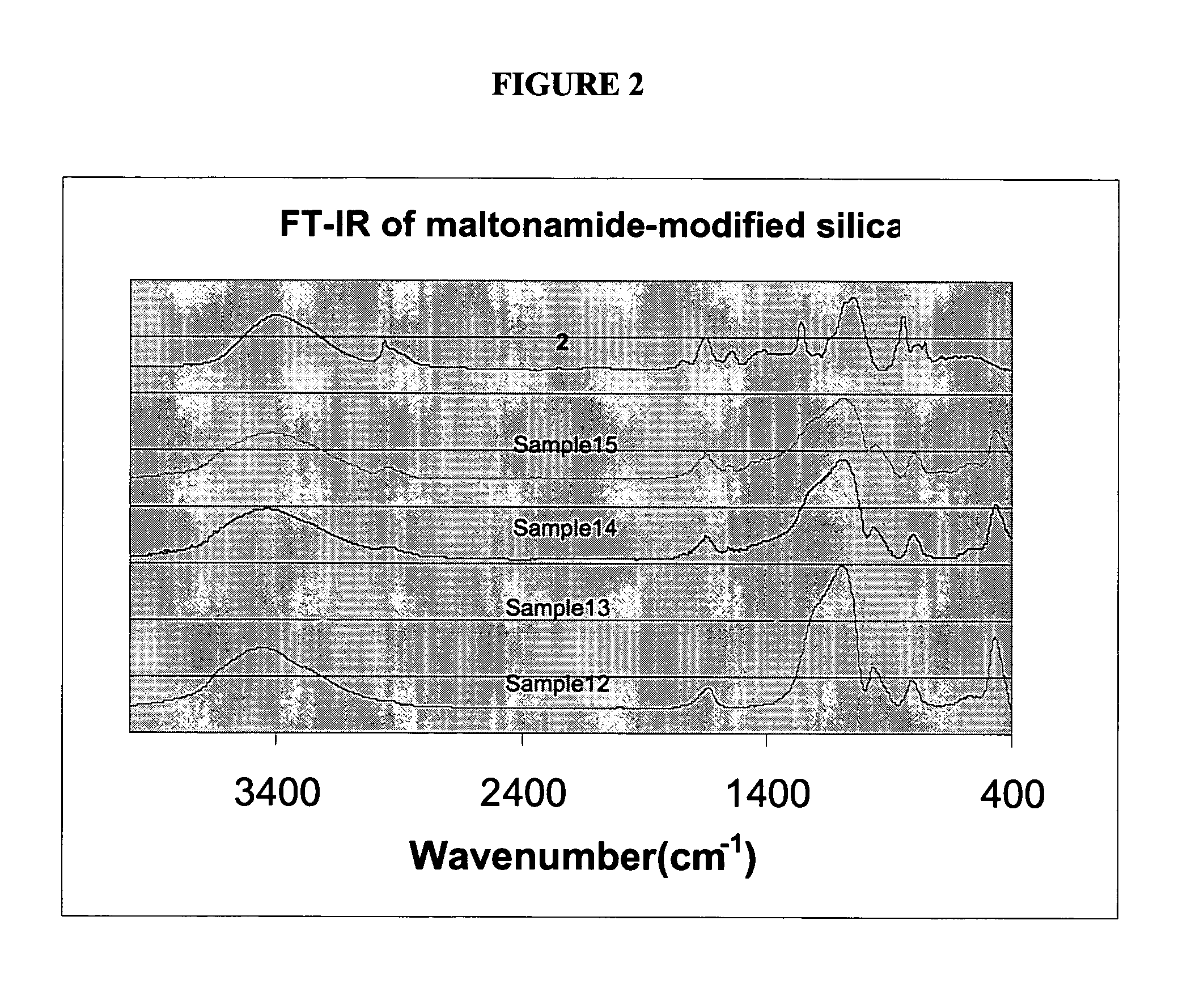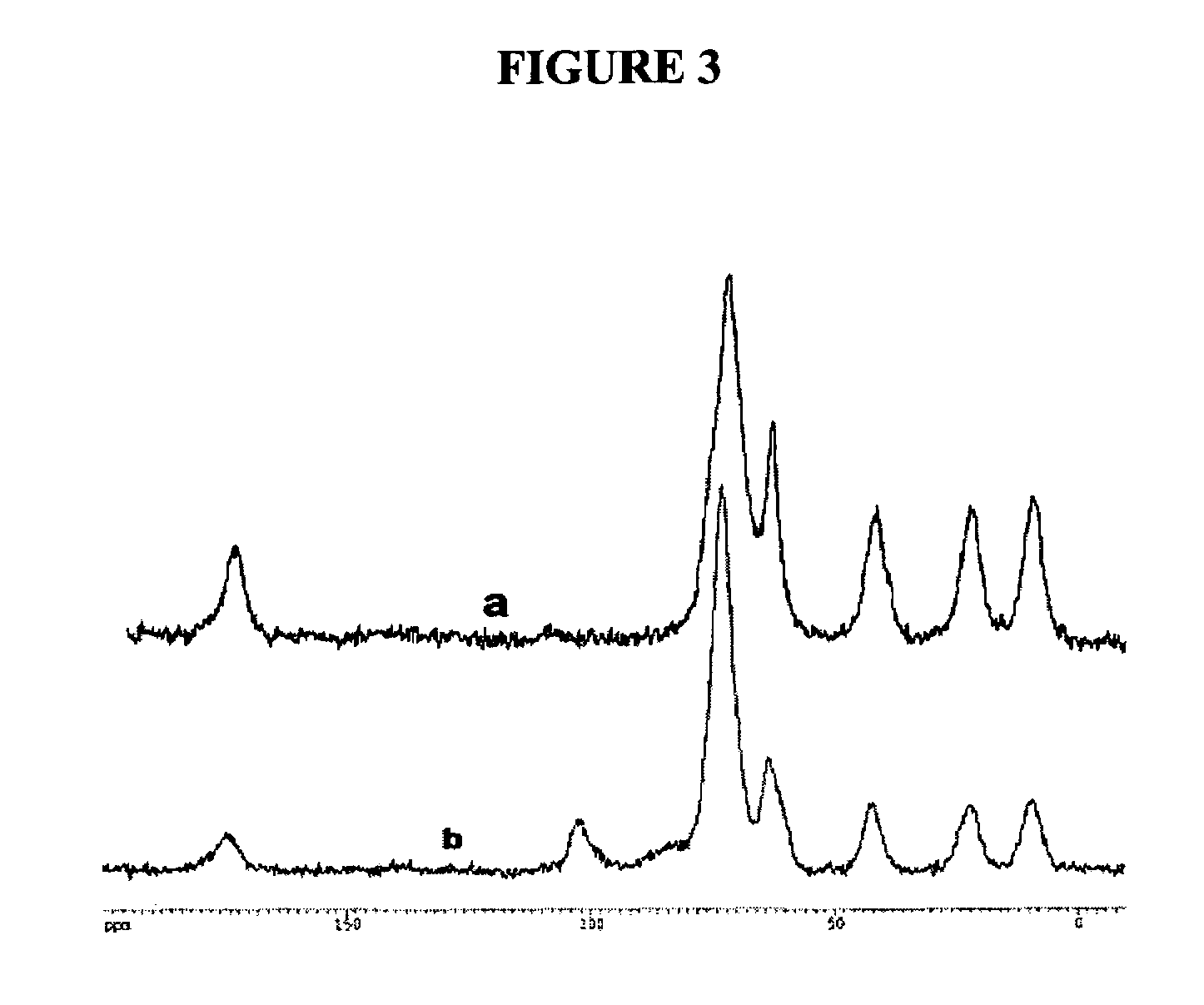Protein compatible methods and compounds for controlling the morphology and shrinkage of silica derived from polyol-modified silanes
- Summary
- Abstract
- Description
- Claims
- Application Information
AI Technical Summary
Benefits of technology
Problems solved by technology
Method used
Image
Examples
example 1
Preparation of Silsesquioxane Precursors
[0167]GluconamideSi, 1. To a solution of D-gluconolactone (0.91 g, 5.2 mmol) in DMSO (10 mL) and EtOH (5 mL) was added 3-aminopropyltriethoxysilane (1.11 g, 5.0 mmol). The mixture was stirred at 60° C. for 20 h. The solvents were evaporated under vacuum and oil residue was dissolved in dichloromethane. Unreacted D-gluconolactone was filtered off, the filtrate was concentrated and added to a large amount of pentane. The white precipitate was collected and dried in vacuo to give 1 as pale yellow solid, 1.83 g (92% yield). 1H NMR (200.2 MHz, d6-DMSO): δ 0.50 (SiCH2), 1.12 (t, 9H, J=6.98 Hz, SiOCH2CH3), 1.45 (m, br, 2H, SiCH2CH2), 3.04 (m, 2H, CH2NHCO), 3.74 (q, J=6.98 Hz, 6H, SiOCH2CH3), 3.40-5.32 (m, glucose ring CH and CH2, and OH), 7.61 (s, br., 1H, NHCO). 13C NMR (50.3 MHz, d6-DMSO): δ 7.8 (SiCH2), 18.7-18.9 (SiOCH2CH3), 23.3 (SiCH2CH2), 41.5 (CH2NHCO), 58.3 (SiOCH2CH3, overlapped), 64.0, 70.7, 72.1, 74.2, 73.0 (glucose ring CH and CH2), 172....
example 2
Preparation of PEO-Silyl Additives
[0171][(CH2CH2O)p(CH2CH═CH2)2, 4a: The reaction was carried out under N2 atmosphere to which a small amount of dry air had been added. To a solution of poly(ethylene glycol) (average MW 200, 10.0 g, 50 mmol) in THF (100 mL) at 0° C. was added NaH (2.4 g, 100.0 mmol) slowly over 30 min. The mixture was allowed to warm up to room temperature and stirred for 2 h. The mixture was cooled down to 0° C., allyl bromide (12.1 g, 100.0 mmol) was added. The mixture was warmed up to room temperature and stirred for further 15 h. White precipitate was filtered off and washed with THF (3×10 mL). The combined filtrate and washing solution and THF was evaporated to give pale yellow crude product. The crude product was purified by chromatography (SiO2, 2% MeOH in CH2Cl2 as eluent) give allyl terminated poly(ethylene glycol), 4a as colorless oil, 11.1 g, (ca. 76% yield). 1H NMR (200.2 MHz, CDCl3): δ 3.54-3.62 (m, 18H, PEO OCH2), 3.96 (dd, 1H, J=5.6 Hz, J=1.4 Hz, CH2═...
example 3
Preparation of DGS / Modified PEO Gel
[0180]DGS (0.2648 g, 1.27 mmol) was mixed with (EtO)3Si(CH2)3PEO(CH2)3Si(OEt)3 (Example 3, 0.1274 g, 0.053 mmol) and added with water (600 L, 33.3 mmol). The mixture was sonicated at 0° C. for 1.5 h during which time a turbid solution formed. Then TRIS buffer (600 L, 50 mM, pH=8.4) was added. The gel formed starting at the bottom of the solution after 5 min.
PUM
| Property | Measurement | Unit |
|---|---|---|
| Power | aaaaa | aaaaa |
| Concentration | aaaaa | aaaaa |
| Molar mass | aaaaa | aaaaa |
Abstract
Description
Claims
Application Information
 Login to View More
Login to View More - R&D
- Intellectual Property
- Life Sciences
- Materials
- Tech Scout
- Unparalleled Data Quality
- Higher Quality Content
- 60% Fewer Hallucinations
Browse by: Latest US Patents, China's latest patents, Technical Efficacy Thesaurus, Application Domain, Technology Topic, Popular Technical Reports.
© 2025 PatSnap. All rights reserved.Legal|Privacy policy|Modern Slavery Act Transparency Statement|Sitemap|About US| Contact US: help@patsnap.com



